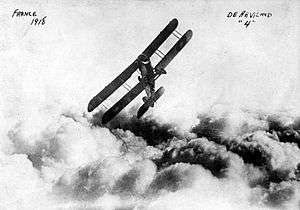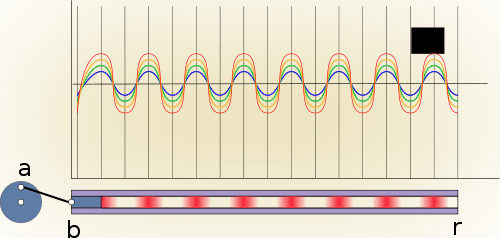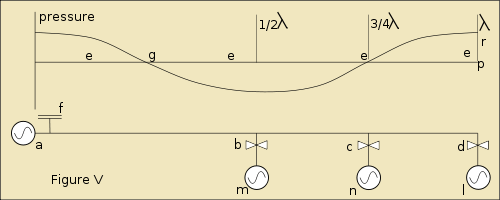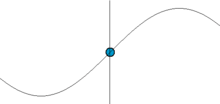Theory of sonics
The theory of sonics is a branch of continuum mechanics which describes the transmission of mechanical energy through vibrations. The birth of the theory of sonics[1] can be considered the publication of the book A treatise on transmission of power by vibrations in 1918 by the Romanian scientist Gogu Constantinescu.
ONE of the fundamental problems of mechanical engineering is that of transmitting energy found in nature, after suitable transformation, to some point at which can be made available for performing useful work. The methods of transmitting power known and practised by engineers are broadly included in two classes: mechanical including hydraulic, pneumatic and wire rope methods; and electrical methods....According to the new system, energy is transmitted from one point to another, which may be at a considerable distance, by means of impressed variations of pressure or tension producing longitudinal vibrations in solid, liquid or gaseous columns. The energy is transmitted by periodic changes of pressure and volume in the longitudinal direction and may be described as wave transmission of power, or mechanical wave transmission. – Gogu Constantinescu[2][3]
Later on the theory was expanded in electro-sonic, hydro-sonic, sonostereo-sonic and thermo-sonic. The theory was the first chapter of compressible flow applications and has stated for the first time the mathematical theory of compressible fluid, and was considered a branch of continuum mechanics.The laws discovered by Constantinescu, used in sonicity are the same with the laws used in electricity.
Book chapters
The book A treatise on transmission of power by vibrations has the following chapters:
- Introductory
- Elementary physical principles
- Definitions
- Effects of capacity, inertia, friction, and leakage on alternating currents
- Waves in long pipes
- Alternating in long pipes allowing for Friction
- Theory of displacements – motors
- Theory of resonators
- High-frequency currents
- Charged lines
- Transformers
George Constantinescu defined his work as follow.
Theory of sonics: applications

- The Constantinesco synchronization gear, used on military aircraft in order to allow them to target opponents without damaging their own propellers.
- Automatic gear
- Sonic Drilling, was one of the first applications developed by Constantinescu. A sonic drill head works by sending high frequency resonant vibrations down the drill string to the drill bit, while the operator controls these frequencies to suit the specific conditions of the soil/rock geology.
- Torque Converter.[4] A mechanical application of sonic theory on the transmission of power by vibrations. Power is transmitted from the engine to the output shaft through a system of oscillating levers and inertias.
- Sonic Engine
Elementary physical principles
If v is the velocity of which waves travel along the pipe, and n the number of the revolutions of the crank a
The wavelength λ is =v/n
Assuming that the pipe is finite and closed at the point r situated at a distance which is multiple of λ, and considering that the piston is smaller than wavelength, at r the wave compression is stopped and reflected, the reflected wave traveling back along the pipe.
| Elementary physical principles | Description |
|---|---|
 Figure I Suppose the crank a to be rotating uniformly, causing the piston b to reciprocate in the pipe c, which is full of liquid. At each in stroke of the piston a zone of high pressure is formed, and these zones, shown by shading, travel along the pipe away from the piston; between every pair of high pressures zones is a zone of light pressure shown in the picture. The pressure at any point in the pipe will go through a series of values from a maximum to a minimum. | |
 Figure II Assuming that the pipe is finite and closed at the point r situated at a distance which is multiple of λ, and considering that the piston is smaller than the wavelength, at r the wave compression is stopped and reflected, the reflected wave traveling back along the pipe.If the crank continues rotation at uniform speed, a zone of maximum pressure will start from the piston at the same time the reflected wave cme to the piston, as a result the maximum pressure will double. At next rotation the amplitude is increased, and so on, till the pipe burst. | |
 Figure III If instead of a closing pipe we have a piston at r;the wave will be similar at piston b and piston m,the piston m therefore will have the same energy as the piston b; if the distance between the b and m is not a multiple of λ the movement of m will differ in phase compared with the piston b. | |
 Figure IV If more energy is produced by piston b then is taken by piston m the energy will be reflected by piston m in pipe, and the energy will accumulate till the pipe burst.If we have a large volume vessel d, compared with the stroke volume of piston b, the capacity d will act as a spring taking out the energy of direct or reflected waves at high pressure, and giving back energy when pressure falls. The mean pressure in d and in the pipe will be the same. The result of reflected waves will be a stationary wave in pipe with no increase of energy, and the pressure in the pipe will never exceed the pressure limit. | |
 Figure V Waves are transmitted by a reciprocating piston along the pipe eeee. The pipe is closed at p, a distance of one complete wavelength. There are branches at one-half, three-quarters and one full wavelength distances. If p is open and d is open, the motor l will rotate synchronous with motor a. If all valves are closed, there will be a stationary wave with extreme values at λ and λ/2, (points b and d,) where the flow will be zero, and where the pressure will alternate between maximum and minimum values determined by the capacity of reservoir f. The maximum and minimum points do not move along the pipe, and no energy flows from generator a. If valve b is open, the motor m is able to take the energy from the line, the stationary half-wave between a and b being replaced by a traveling wave; between b and p a stationary wave will persist. If only valve c is open, since at this point the variation of pressure is always zero, no energy can be taken out by the motor n, and the stationary wave will persist. If the motor is connected in an intermediary point, part of the energy will be taken out by the motor while the stationary wave will persist at reduced amplitude. If the motor l is not capable of consuming all the energy of the generator a, then there will be a traveling wave a and a stationary wave. Therefore, there will be no point in the pipe where the pressure variation will be zero, and consequently, a motor connected at any point of the pipe will be able to use a portion of generated energy. |
Definitions
Alternating fluid currents
Considering any flow or pipes,if:
- ω = the area section of the pipe measured in square centimeters;
- v =the velocity of the fluid at any moment in centimeters per second;
and
- i =the flow of liquid in square cubic centimeters per seconds,
then we have:
- i =vω
Assuming that the fluid current is produced by a piston having a simple harmonic movement, in a piston cylinder having a section Ω. If we have:
- r =the equivalent of driving crank in centimeters
- a =the angular velocity of the crank or the pulsations in radians degree per second.
- n =the number of crank rotations per second.
Then:
- The flow from the cylinder to the pipe is: i = I sin(at+φ)
Where:
- I = raΩ (the maximum alternating flow in square centimeters per second; Amplitude of the flow.
- t = time in seconds
- φ = the angle of the phase
If T= period of a complete alternation (one revolution of the crank) then:
- a = 2πn; where n = 1/T
The effective current can be defined by the equation:
- and the effective velocity is :
The stoke volume δ will be given by the relation:
Alternating pressures
The alternating pressures are very similar with alternating currents in electricity. In a pipe were the currents are flowing, we will have:
- ;where H is the maximum alternating pressure measured in kilograms per square centimeter. the angle of phase; representing the mean pressure in the pipe.
Considering the above formulas:
- the minimum pressure is and maximum pressure is
If p1 is the pressure at an arbitrary point and p2 pressure in another arbitrary point:
- The difference is defined as instantaneous hydromotive force between point p1 and p2, H representing the amplitude.
The effective hydromotive force will be:
Friction
In alternating current flowing a pipe the friction appear at the surface of the pipe and also in liquid itself. Therefore the relation between the hydromotive and current can be written:
- ; where R= coefficient of friction in
Using experiments R may be calculated from formula:
- ;
Where:
- is the density of the liquid in kg per cm.3
- l is length of the pipe in cm.
- g gravitational acceleration in cm. per sec.2
- section of the pipe in square centimeters.
- veff the effective velocity
- d internal diameter of the pipe in centimeters.
- for water this is an approximation made by experiments.
- h is instantaneous hydromotive force
If we introduce in the formula, we get:
- this is equivalent with:
- ; introducing k in formula, result thar
For pipes with greater diameter greater velocity can be achieve for same value of k. The loss of power due to friction is calculated with:
- , putting h=Ri result:
- Therefore:
Capacity and condensers
Definition: Hydraulic condensers are appliances for making alterations in value of fluid currents, pressures or phases of alternating fluid currents. The apparatus usually consists of a mobile solid body, which is dividing the liquid column, and fixed elastically in a middle position, in such way that it follows the movements of the liquid column.
The principal function of hydraulic condensers is to counteract inertia effects due to moving masses.
| Hydraulic Condenser Drawing | Theory |
|---|---|
 Hydraulic Condenser Example  Hooke's law for spring ; in this case x=f=piston movement.  Simple Harmonic The principal function of hydraulic condensers is to counteract inertia effects due to moving masses. The capacity C of a condenser consisting of a piston of section ω on which the liquid pressure is acting, held in mean position by means of springs, is given by the equation:
where:
and
For a spring wire of circular section: Where
and
Therefore:
m being a constant depending on σ and G. If d is the diameter of the spring wire and the D the mean diameter of the spring. Then: so that: if we consider :: then: The above equations are used in order to calculate the springs required for a condenser of a given capacity required to work at a given maximum stress. |
Notes
- ↑ https://archive.org/stream/theoryofwavetran00consrich#page/n3/mode/2up
- ↑ Constantinesco, G. Theory of Sonics: A Treatise on Transmission of Power by Vibrations. The Admiralty, London, 1918
- ↑ https://archive.org/stream/theoryofwavetran00consrich#page/n3/mode/2up
- ↑ http://www.imsar.ro/SISOM_Papers_2007/D_18.pdf
References
- https://archive.org/stream/theoryofwavetran00consrich#page/n3/mode/2up
- http://www.rexresearch.com/constran/1constran.htm
- Constantinesco, G. Theory of Sonics: A Treatise on Transmission of Power by Vibrations. The Admiralty, London, 1918.
- Constantinesco, G., Sonics. Trans. Soc. of Engineers, London, June 1959
- Clark, R.Edison, The Man Who Made the Future. Macdonald and Jane's, London, 1977.
- McNeil, I., George Constantinesco, 1881–1965 and the Development of Sonic Power Transmission. Excerpt from volume 54, Trans. of the Newcomen Society, London, 1982–83.
- Constantinesco, G., A Hundred Years of Development in Mechanical Engineering. Trans. Soc. of Engineers, London, Sept. 1954.
- http://www.gs-harper.com/Mining_Research/Power/Sonics005.asp
- Constantinesco, G. Transmission of Power the Present, the Future. Paper read before the North East Coast Institution of Engineers and Shipbuilders in Newcastle upon Tyne, on the 4th December, 1925. Reprinted by order of the Council. North East Coast Institution of Engineers and Shipbuilders, Newcastle upon Tyne, 1926.
- http://www.rri.ro/arh-art.shtml?lang=1&sec=9&art=3596
- http://www.utcluj.ro/download/doctorat/Rezumat_Carmen_Bal.pdf
- http://www.rexresearch.com/constran/1constran.htm
- http://imtuoradea.ro/auo.fmte/files-2008/MECANICA_files/MARCU%20FLORIN%201.pdf
- http://dynamicsflorio.webs.com/arotmm.htm